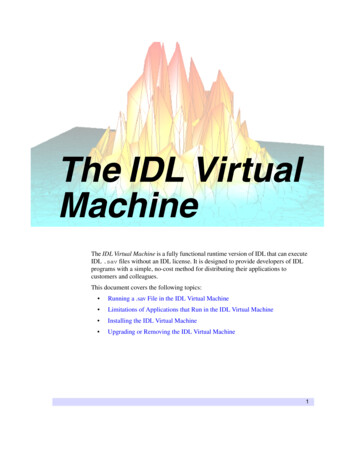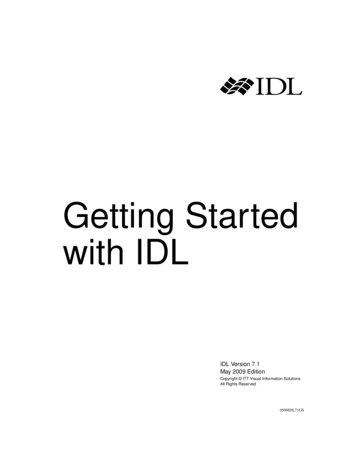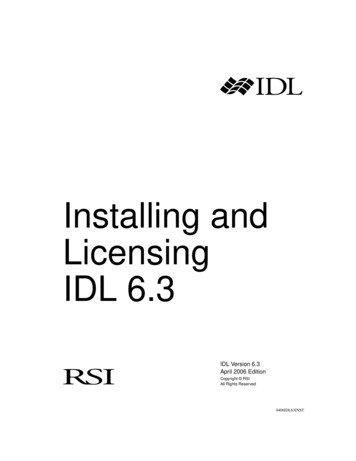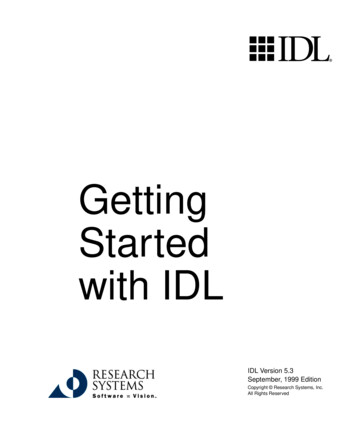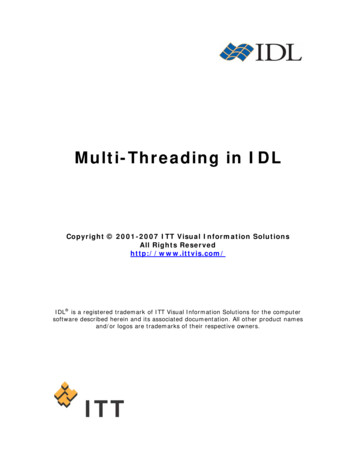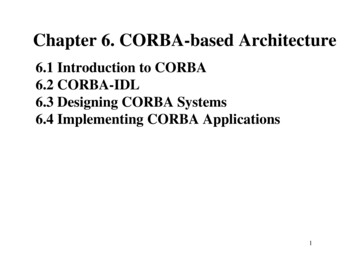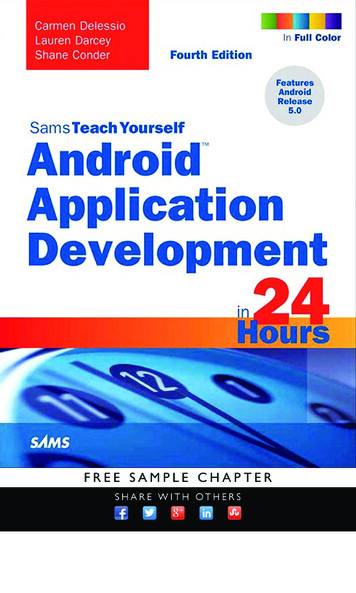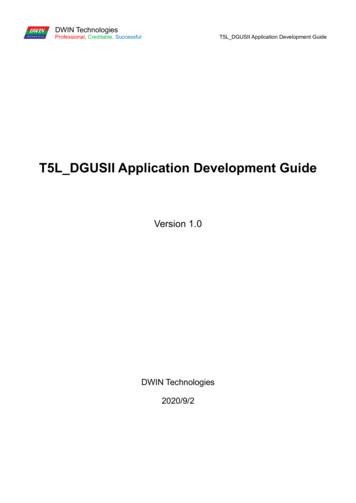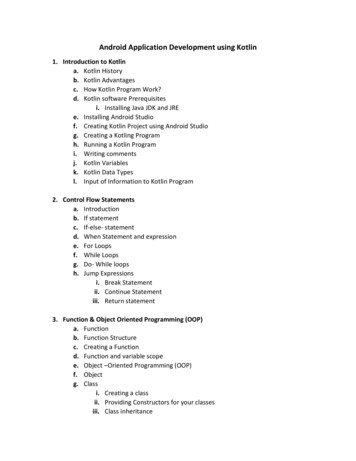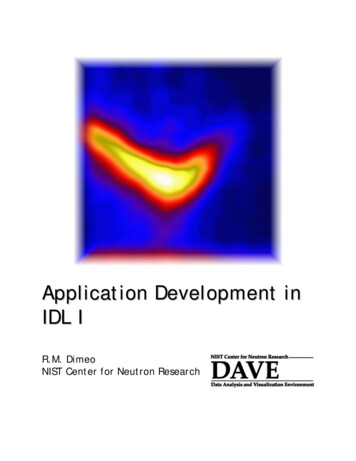
Transcription
Application Development inIDL IR.M. DimeoNIST Center for Neutron Research
ContentsChapter 1 Introduction . 4Chapter 2 Data types and variables . 6Scalars . 6Arrays . 11Pointers. 15System variables . 18Chapter 3 Functions and procedures. 20Mathematics . 20Syntax. 21Convolution . 29Synthesizing data . 34Chapter 4 Accelerating your IDL code . 38Simple first examples . 38Matrix multiplication . 40Eliminating a double loop . 42Functions built for speed . 43Rebinning data . 44Convolution redux . 52Chapter 5-Data visualization . 57Simple plots. 57Surface and image plots . 65Animating data . 67Example showing convergence of Fourier Series . 69Chapter 6-Data Analysis. 72Fitting a straight line with LINFIT . 72Using CURVEFIT . 73Using MPCURVEFIT . 74Analyzing neutron scattering data with MPCURVEFIT . 76Visualizing the intermediate fitting steps . 80A diversion: Monte-Carlo estimation of parameter uncertainties . 83Chapter 7-User Interface basics . 85Event-driven programming . 85A UI with user input . 89Interacting with a plot window . 93Distributing your application with the IDL Virtual Machine . 98Chapter 8-Writing a GUI application .100Design specifications and functional requirements .100Implementation plan .101GUI Layout .101Event handler, data, and auxiliary procedures .103Chapter 9-Writing a multi-module GUI application.122Design specifications and functional requirements .122Implementation plan .122Suppressing multiple instances of an application.124Chapter 10-Plugging your application into DAVE.125What is DAVE? .125Adding your IDL application to DAVE .125More details of the DAVE pointer .129Working with the davePtr .1331
2
AcknowledgmentsA number of sources made contributions to this manual. In particular John Copleyprovided source code and some text in the discussion of data rebinning. RichardAzuah provided most of the text in Chapter 10 on how to add modules to DAVE andthe discussion of the DAVE internal data format. Richard Azuah, Larry Kneller, andJohn Copley all provided valuable feedback on various topics discussed throughoutthis manual.This work is based upon activities supported by the National Science Foundation underAgreement no. DMR-0086210.3
Chapter 1 IntroductionThis course manual grew out of a set of notes and programs that I wrote for teachinga course on introductory application development in IDL for neutron scatteringscientists at the NIST Center for Neutron Research (NCNR). Because this manual isbased on a set of notes it should not be considered a formal text for learning IDL.There are a number of excellent texts on this subject (such as IDL ProgrammingTechniques by David Fanning, Practical IDL Programming by Liam Gumley and otherslisted below). Rather it is a reference and brief summary of material discussed in theNCNR’s introductory course.The course is targeted to scientists interested in using IDL for the purpose ofmanipulating, reducing, visualizing, and analyzing neutron scattering data. Differentreaders will have different end goals. Some will want to write their own datamanipulation programs for their own research. Research scientists who need to getscientific results out quickly fall into this first category. Others will want to writeapplications complete with a graphical-user-interface for use by non-experts.Instrument scientists who wish to spend as little time as is necessary helping noviceusers through the data reduction and analysis phase of their experiments fall into thissecond category. Still other developers will want to find some intermediate ground inwhich the end-user of an application can script their own high-level commands whileoffering the simplicity of a graphical user interface. This programming languageoffers all of these capabilities. In this course we will focus on the first two pointsdiscussed above, though the last point is addressed to some extent in the secondcourse, Application Development in IDL II.This course will serve as an introduction to programming in IDL from writing scripts ofsimple commands in an interactive batch mode to creating end-user applications witha graphical user-interface (GUI). Participants in this course will learn thefundamentals of IDL programming, how to use IDL to analyze data, how to write anapplication with a GUI, how to distribute an application using the free IDL VirtualMachine, how to write a relatively sophisticated data visualization application withinteractive features, and how to add a standalone GUI application into the DAVE (DataAnalysis and Visualization Environment) software system. Neither object graphics norobject-oriented programming are covered in this course. Object-orientedprogramming in IDL is the topic of the next course.Although IDL is an appropriate platform for developing applications as stated above,there are a substantial number of routines written by software developers that youmight find extremely useful in your own applications. Some such routines will bediscussed here. Some of these third party programs will be needed for this course. Inaddition to these third-party programs you can download the programs for this coursefrom a link at the following web address:4
ost of what I learned (and continue to learn) about IDL comes from the greatresources available, including a huge IDL programming community. The list belowcontains a few that you might find useful.Many excellent texts exist on IDL programming:IDL Programming Techniques, David FanningApplication Development in IDL, Ronn KlingPractical IDL Programming, Liam GumleyPower Graphics with IDL, Ronn KlingFurthermore there are numerous on-line resources available:www.dfanning.comDavid Fanning's site has lots of very nice widget (GUI) programs that are writtenin a very clear and pedagogical manner. Great for learning GUI programming!fermi.jhuapl.edu/s1r/idl/s1rlib/local idl.htmlThe Johns Hopkins Applied Physics Lab has lots of plotting and printing tools aswell as some general utilities. The categories of IDL code found here are toonumerous to mention.cow.physics.wisc.edu/ craigm/idl/idl.htmlCraig Markwardt's site contains many math routines, including arguably the bestcurve fitting routines for IDL. His MPFIT routine and its supporting proceduresare the basis for PAN (the curve fitting utility in DAVE).www.kilvarock.comRonn Kling has written some nice widget and object graphics books listedabove. His web site contains freeware and code you can buy written in IDL.comp.lang.idl-pvwaveThe IDL newsgroup is a very friendly bulleting board with many useful tips anda searchable archive. If you have a question, it will likely get a response sameday. I check for the latest postings frequently.www.metvis.com.au/idl/This has a terrific and fairly complete list of IDL resources available on theweb.Finally I also have a number of IDL programs available for download from my web site:www.ncnr.nist.gov/staff/dimeo/idl programs.html.5
Chapter 2 Data types and variablesIn this first chapter we discuss (very briefly) some of the commonly used data types inIDL.ScalarsThere are many data types available for use in IDL and we will discuss here how to usesome of the most common. We will perform most of our work in this chapter at theIDL command line so the output should look familiar. First let’s see how IDL views thefollowing variables (note that the ampersand symbol & allows multiple statements onone line):IDL IDL TIDL UIDL VIDL WIDL XIDL YIDL Zt 6LL & u 0B & v 1L & w 1 & x 0.0 & y 1D & z 'A'help,tLONG64 6help,uBYTE 0help,vLONG 1help,wINT 1help,xFLOAT 0.000000help,yDOUBLE 1.0000000help,zSTRING 'A'As a word of explanation, the procedure named HELP is called with a commaprior to the variable name about which the user is inquiring. Procedures canbe called with the following syntax:IDL foo, arg1,arg2,arg3Where foo is the name of the procedure and arg1, arg2, and arg3 can beinput or output parameters. Of course there is no limit to the number ofparameters that can be passed in to or out of a procedure. Procedures andfunctions are discussed in more detail in Chapter 3.If a variable has not been defined then help tells us it is undefined. For instanceconsider the following example.IDL help,xxXXUNDEFINED Undefined 6
Since we had assigned any value to the variable name xx it is undefined. If we try toprint this variable then we will get an error.IDL print,xx% PRINT: Variable is undefined: XX.% Execution halted at: MAIN In addition to the common data types listed above, structures, pointer variables, andobjects are also supported in IDL. We will not be discussing object variables in thiscourse.Structure variables, which are a convenient way to a group members of different datatypes, come in two types: named and anonymous. The main difference between thetwo types is that you cannot modify the contents (“tags”) of a named structure afterit has been created (except by resetting your IDL session). As an example of ananonymous structure, consider the following:IDL steven {age:25,weight:165.0,height:152.0}In this structure, whose variable name is steven, there are three tags. The tagnames, age, weight, and height, are of type integer, float, and float. The names canbe obtained via the tag names function and the number of tags can be obtained viathe n tags function.IDL print,tag names(steven),n tags(steven)AGE WEIGHT HEIGHT3TAG NAMES and N TAGS are functions and the syntax, discussed more fully inchapter 3, is shown below:IDL ret foo(arg1,arg2,arg3)Here foo is the name of the function and arg1, arg2, and arg3 can be input or outputparameters. As in procedures there is no limit to the number of parameters that can be passedin to or out of a function.The natural way to retrieve the values of each of the structure tags is using thefollowing convention in which the tag name is appended with a period after thestructure variable name:IDL 000152.000Alternatively you can use the lesser-used method involving the tag subscripts knownas field subscripting. Note that this only works with parentheses (not squarebrackets)!IDL print,steven.(0),steven.(1),steven.(2)7
25165.000152.000You can set the structure keyword of tag names function to return the name of thestructure. Since this structure is anonymous, no specific name is returned when helpis invoked as shown below:IDL help,stevenSTEVENSTRUCT - Anonymous Array[1]Note that this tells us that it is an anonymous structure array with a single member.We will not go into the details here but an array with one member is not the samething as a scalar. Suffice it to say at this point, creation of a structure in the mannershown above actually creates a structure array.An example of a named structure is given by the following:IDL str {neutron scatterer,name:'William Gates',salary:865114,height:1.78}In this named structure, the variable name str is assigned to a structure with threefields: name, salary, and height. Since this is a named structure, help yields thefollowing:IDL help,strSTRSTRUCT - NEUTRON SCATTERER Array[1]Note that we have all of the same structure syntax as with the anonymous structure inthe previous example. Therefore we can extract information from the structure asfollows:IDL print,str.salary865114which is equivalent toIDL print,str.(1)865114With named structures we can run into problems by attempting to redefine the sizeand variable type of the individual fields. For instance, let's say that we want tochange our definition after we have already defined it previously. For instance in thefollowing statement we modify the salary to be a floating point scalar:IDL str {neutron scatterer,name:'William Gates',salary:865124.5,height:1.78}Now if we examine the variable type of str.salary using help we findIDL help,str.salary Expression LONG 8651248
which indicates that the type cannot be changed.We can attempt the same with the anonymous structure by changing the height field,previously a floating point number, to an integer,IDL steven {age:25,weight:165.0,height:152}which yields the following variable type for str.height using helpIDL help,steven.height Expression INT 152Therefore it is possible to change the variable type of a field in an anonymousstructure (if we are not changing the size) but even this is forbidden in a namedstructure.It is forbidden in either case to change the size of the variable in any of the fields.For instance, if we attempt to resize the height field of the anonymous structuresteven as follows then we get an error message telling us that we are not allowed toresize the field.IDL steven.height findgen(5)% Expression must be a scalar in this context: INT% Execution halted at: MAIN Array[5] .Note that findgen is a function that returns an array. Arrays are discussed in the nextsection.Another difference between anonymous and named structures is that you cannotredefine the number nor identity of fields in a named structure. This is permitted inanonymous structures as the following example shows. Here we will redefine thestructure by removing the age field.IDL steven {weight:165.0,height:152}IDL help,stevenSTEVENSTRUCT - Anonymous Array[1]This is acceptable because now the structure is composed of two fields. However weget an error when we try to do this with a named structure. We try to redefine thestructure without the salary or height fields.IDL str {neutron scatterer,name:'William Gates'}% Wrong number of tags defined for structure: NEUTRON SCATTERER.% Execution halted at: MAIN One programming technique that can be quite useful when it is necessary to create anumber of similar structures is automatic structure definition. We will make use of9
this in the chapter on GUI programming, especially as it pertains to plotting data inwindows so we will discuss automatic structure definition briefly here.In an automatic structure definition we can create a named structure with each of thefields filled with known variable types. As an example let's define a structure for aused car using the automatic structure definition. We want four fields in thestructure: year (integer), model (string), make (string), and mileage (double). Theprocedure below provides the definition.pro used car definevoid {used car,year:0,model:'',make:'',mileage:0Dend }Type this code into a new editor window and save it as used car define.pro.There are a number of points to note about this procedure. First the name of theprocedure includes the name used car but there is a double-underscore after it andbefore define. This syntax is required for any automatic structure definition. Theother thing to notice is that we have used place-holders on the right hand side of eachcolon which tells IDL the variable type that is to be associated with each of the fields.Finally we use the name "void" in the definition because the variable name within thedefinition statement is not used, thus it is not important.We can create a structure now using this automatic structure definition. At the IDLcommand line type the following sequence of commands:IDL IDL IDL IDL IDL car1 {used car}car1.year 1996car1.make 'Honda'car1.model 'Accord'car1.mileage 135122.5The first statement associates an instance of the named structure with the variablename car1. The remaining statements identify particular values with each of thefields. If we had not filled in these values as shown above then the values would beidentical to those place-holders given to the fields in the definition procedure,used car define.We can use some of the built-in IDL functions to extract the contents of the structurewe just created as follows.IDL for i 0,n tags(car1)-1 do print,car1.(i)1
fundamentals of IDL programming, how to use IDL to analyze data, how to write an application with a GUI, how to distribute an application using the free IDL Virtual Machine, how to write a relatively sophisticated data visualization application with interactive features, and ho
